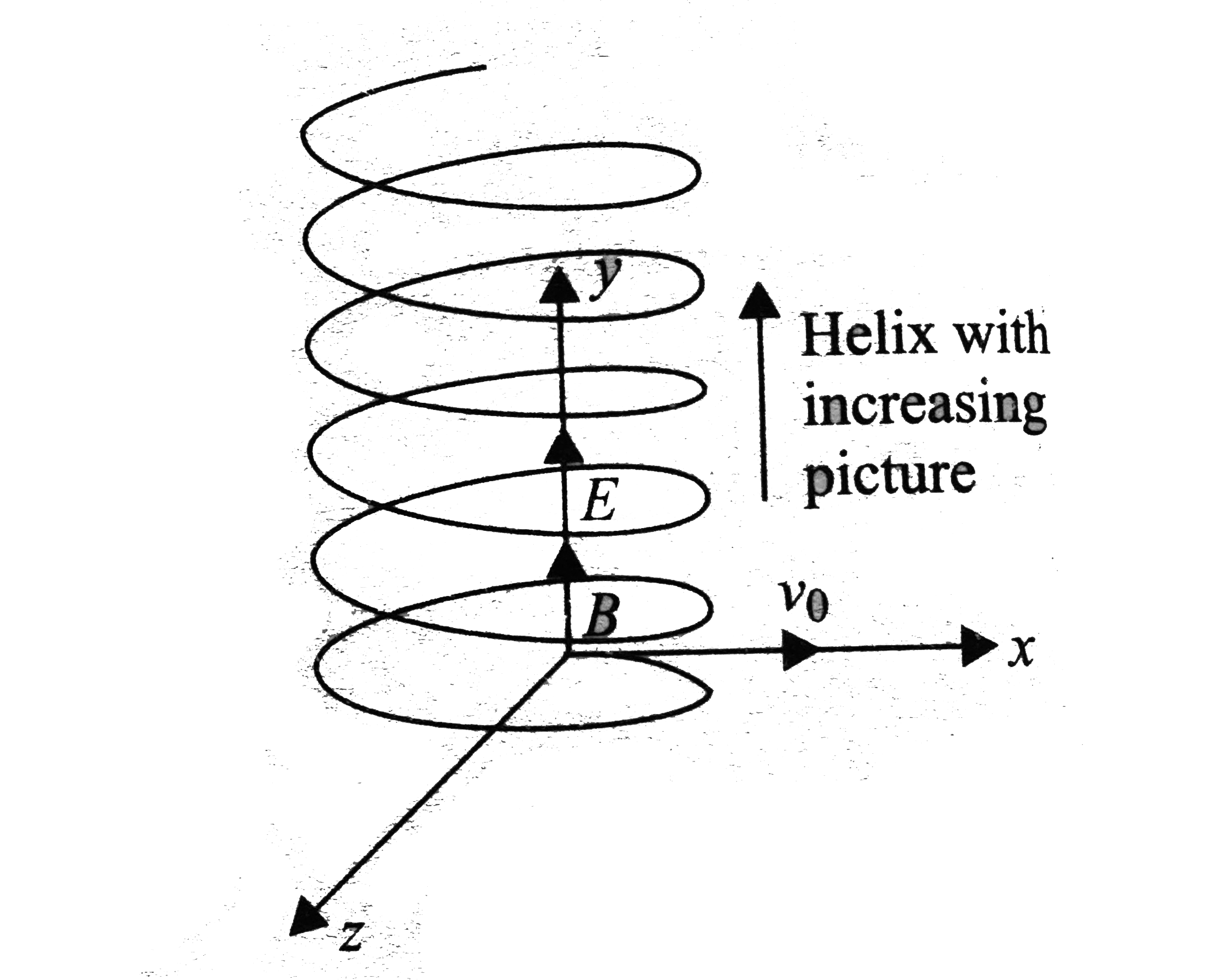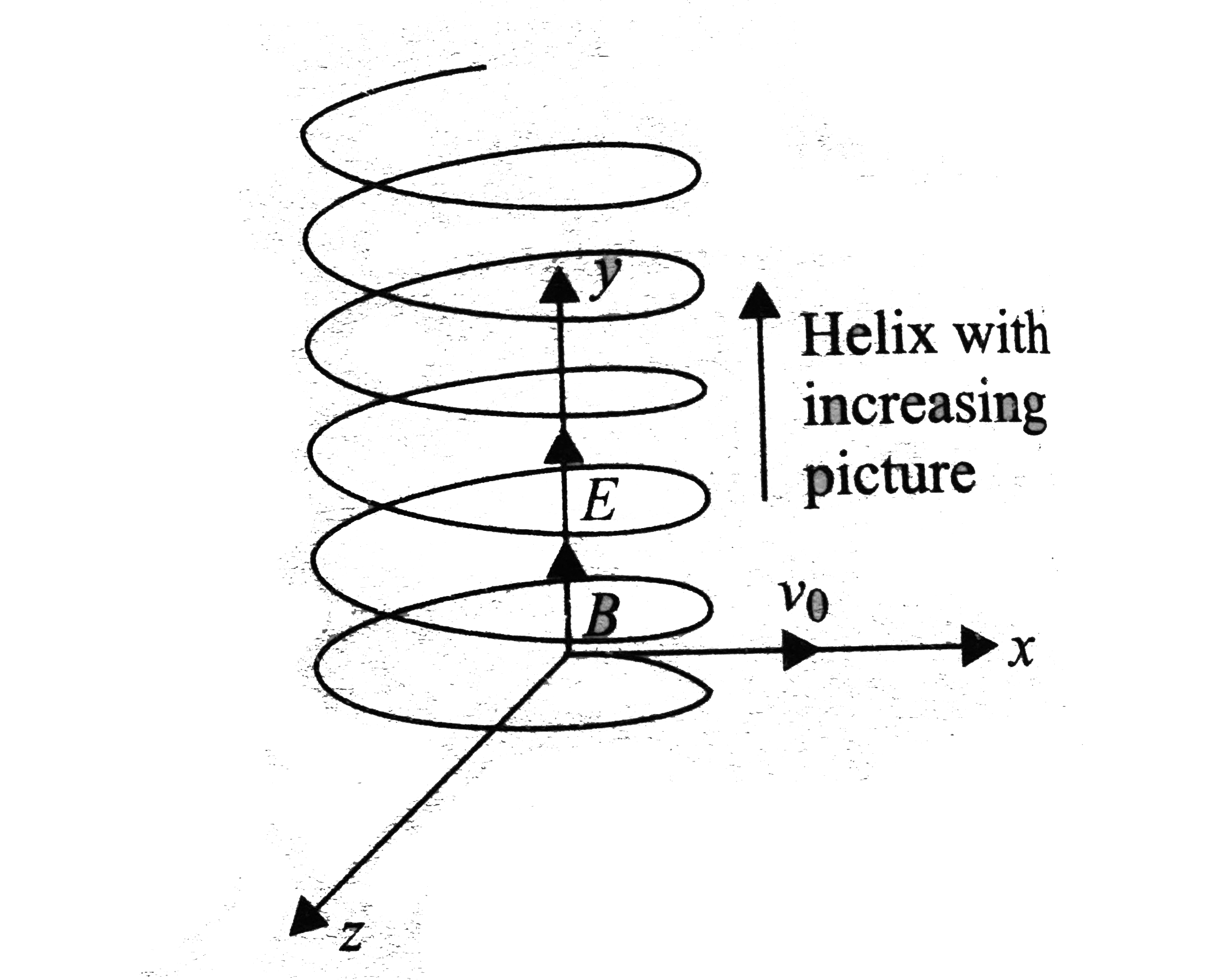Uniform electric field E and magnetic field B, respectively, are along y-axis as shown in the figure. A particle with specific charge q/m leaves the origin O in the direction of x-axis with an initial non-relativistic speed v0.Thec∞rd∈ateY_(n) of the particle when it crosses the y-axis for the nth time is:
2π2mn2EqB2
π2mn2EqB2
2π2mn2E3qB2
√3π2mn2EqB2
The correct Answer is:A
dvydt=qEm= constant
constant
The motion of the particle is equivalent to circular motion in xz plane with uniform acceleration in
y-direction. The magnetic force cannot change the magnitude of velocity. The y component of velocity,
vy=qEmt, The y-coordinate at time y=12qEmt2
The time period of circular motion in xz plane T=2πmBq
Let the particle cross y-axis after n rotations, then T=2πmBq
Thus, yn=qE2m×(2πmnqB)2=2π2mn2EqB2
Similar Questions
Uniform electric field E and magnetic field B, respectively, are along y-axis as shown in the figure. A particle with specific charge q/m leaves the origin O in the direction of x-axis with an initial non-relativistic speed v0.

The angle α between the particle’s velocity vector and y-axis at that moment is:
View SolutionUnifrom electric and magnetic fields with strength E and induction B respectively are directed along the y axis (Fig). A particle with specific charge q/m leaves the origin O in the direction of the z axis with an initial non-realtive velocity v0 find:
(a) the coordinate yn of the particle when it crossses then y axis for the nth time,
(b) the angle α between the particle's velocity vector and the y axis at that moment.

View Solution
Knowledge Check
Uniform electric and magnetic fields with strength E and induction B, respectively, are along y-axis as shown in Fig. A particle with specific charge q/m leaves the origin O in the direcction of x-axis with an initial non-relativistic velocity v0

The coordinate y_nofthepartic≤whenitcrossesthey−aξsforthen^(th) time isA2π2mn2EqB2Bπ2mn2EqB2C2π2mn2E3qB2D√3π2mn2EqB2Uniform electric and magnetic fields with strength E and induction B, respectively, are along y-axis as shown in Fig. A particle with specific charge q/m leaves the origin O in the direcction of x-axis with an initial non-relativistic velocity v0

The angle α between the particle's velocity vector and y-axis at and moment isAtan−1(3v0B2πnE)Btan−1(v0BπnE)Ctan−1(v0B√2πnE)Dtan−1(v0B2πnE)A charged particle (charge q, mass m) has velocity v0 at origin in +x direction. In space there is a uniform magnetic field B in -z direction. Find the y coordinate of particle when is crosses y axis.
Amv0qBB2mv0qBCmv02qBDNone of these
Uniform electrilcf and magnetic fields with strength E and B are directed along of x-axis. A particle with specific charge qm leves the origin in the direction of x-axis with an initial velocity v0. Find
a. the y-coordinate of the particle when it crosses the y-xis for nth time.
b. the angle α between the particle's velocity vector adn the y-axis for nth time
View SolutionA uniform electric field,−−→E=E0ˆi and a uniform magnetic field,−−→B=B0ˆi exist in region y>0.A particle hav- ing positive charge q and mass m is projected from the origin with a velocity −−→V=V0ˆi+V0ˆJ. The velocity of the particle when it leaves the region of fields was found to be −−−→V.
(i) Find the ratio E0B0 in terms of v0.
(ii) Find the co-ordinates of the point where the particle leaves the fields.
(iii) Find the minimum speed of the particle during the course of the motion.
View SolutionThere exist uniform magnetic and electric fields of magnitudes 1T and 1Vm−1 respectively, along positive y-axis. A charged particle of mass 1kg and charge 1C is having velocity 1ms−1 along x-axis and is at origin at t=0. Then, the coordinates of the particle at time πs will be
View SolutionA uniform electric field of 500V/m is directed at 150∘ to the positive X-axis, in the X−Y plane as shown in figure

View SolutionA particle with mass m and positive charge q released from rest at the origin as shown in figure. There is a uniform electric field E0in +y direction and uniform magnetic field B0 directed out of the page. The path of the particle as shown is called cycloid. The particle always moves in x−y plane. The velocity at any time t after the start is given as

The time for which the y− coordinate of the particle bomes maximum for the first time is
View Solution